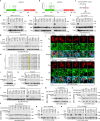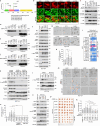Functional annotation of the Hippo pathway somatic mutations in human cancers
- PMID: 39572544
- PMCID: PMC11582751
- DOI: 10.1038/s41467-024-54480-y
Functional annotation of the Hippo pathway somatic mutations in human cancers
Abstract
The Hippo pathway is commonly altered in cancer initiation and progression; however, exactly how this pathway becomes dysregulated to promote human cancer development remains unclear. Here we analyze the Hippo somatic mutations in the human cancer genome and functionally annotate their roles in targeting the Hippo pathway. We identify a total of 85 loss-of-function (LOF) missense mutations for Hippo pathway genes and elucidate their underlying mechanisms. Interestingly, we reveal zinc-finger domain as an integral structure for MOB1 function, whose LOF mutations in head and neck cancer promote tumor growth. Moreover, the schwannoma/meningioma-derived NF2 LOF mutations not only inhibit its tumor suppressive function in the Hippo pathway, but also gain an oncogenic role for NF2 by activating the VANGL-JNK pathway. Collectively, our study not only offers a rich somatic mutation resource for investigating the Hippo pathway in human cancers, but also provides a molecular basis for Hippo-based cancer therapy.
© 2024. The Author(s).
Conflict of interest statement
Competing interests: K.-L.G. is a co-founder of and holds an equity interest in Vivace Therapeutics. The other authors declare no competing interests.
Figures







Similar articles
-
Hippo pathway inactivation through subcellular localization of NF2/merlin in outer cells of mouse embryos.Development. 2024 Jul 15;151(14):dev202639. doi: 10.1242/dev.202639. Epub 2024 Jul 30. Development. 2024. PMID: 39077779
-
Critical roles of phosphoinositides and NF2 in Hippo pathway regulation.Genes Dev. 2020 Apr 1;34(7-8):511-525. doi: 10.1101/gad.333435.119. Epub 2020 Feb 27. Genes Dev. 2020. PMID: 32115406 Free PMC article.
-
Hippo pathway gene mutations in malignant mesothelioma: revealed by RNA and targeted exon sequencing.J Thorac Oncol. 2015 May;10(5):844-851. doi: 10.1097/JTO.0000000000000493. J Thorac Oncol. 2015. PMID: 25902174
-
Molecular mechanisms of Hippo pathway in tumorigenesis: therapeutic implications.Mol Biol Rep. 2025 Feb 27;52(1):267. doi: 10.1007/s11033-025-10372-y. Mol Biol Rep. 2025. PMID: 40014178 Review.
-
Hippo-YAP signaling pathway: A new paradigm for cancer therapy.Int J Cancer. 2015 Nov 15;137(10):2275-86. doi: 10.1002/ijc.29073. Epub 2014 Jul 22. Int J Cancer. 2015. PMID: 25042563 Review.
Cited by
-
Molecular basis and therapeutic implications of binary YAPOn/YAPOff cancer classes.Biochem J. 2025 May 28;482(11):741-61. doi: 10.1042/BCJ20253077. Biochem J. 2025. PMID: 40440076 Free PMC article. Review.
-
HOMER3 orchestrates SRC-YAP1 activity that promotes tumor cell growth and antagonizes anti-tumor immunotherapy in prostate cancer.Oncogene. 2025 Aug 23. doi: 10.1038/s41388-025-03548-0. Online ahead of print. Oncogene. 2025. PMID: 40849586
-
Hippo Pathway Dysregulation in Thymic Epithelial Tumors (TETs): Associations with Clinicopathological Features and Patients' Prognosis.Int J Mol Sci. 2025 Jun 20;26(13):5938. doi: 10.3390/ijms26135938. Int J Mol Sci. 2025. PMID: 40649713 Free PMC article.
References
-
- Ma, S., Meng, Z., Chen, R. & Guan, K. L. The Hippo pathway: biology and pathophysiology. Annu Rev. Biochem88, 577–604 (2019). - PubMed
Publication types
MeSH terms
Substances
Grants and funding
- U54CA217378/U.S. Department of Health & Human Services | NIH | National Cancer Institute (NCI)
- R35GM130367/U.S. Department of Health & Human Services | NIH | National Institute of General Medical Sciences (NIGMS)
- 32370766/National Natural Science Foundation of China (National Science Foundation of China)
- R01 GM143233/GM/NIGMS NIH HHS/United States
- R01GM126048/U.S. Department of Health & Human Services | NIH | National Institute of General Medical Sciences (NIGMS)
- RSG-18-009-01-CCG/American Cancer Society (American Cancer Society, Inc.)
- R01 GM126048/GM/NIGMS NIH HHS/United States
- U54 CA217378/CA/NCI NIH HHS/United States
- P30CA062203/U.S. Department of Health & Human Services | NIH | National Cancer Institute (NCI)
- R01GM143233/U.S. Department of Health & Human Services | NIH | National Institute of General Medical Sciences (NIGMS)
- P30 CA062203/CA/NCI NIH HHS/United States
- R35 GM130367/GM/NIGMS NIH HHS/United States
LinkOut - more resources
Full Text Sources
Medical
Research Materials
Miscellaneous

